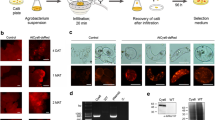Abstract
Cell suspension cultures were established from leaf explants of gentian (Gentiana triflora×G. scabra) for the generation of transgenic plants by particle bombardment. The parameters for the bombardment of suspension culture cells with a particle gun were examined by monitoring the transient expression of a gene for β-glucuronidase driven by the cauliflower mosaic virus (CaMV) 35S promoter. We found that prior culture of suspension culture cells for 5 days on solid medium was optimum for successful particle bombardment. Putative transformed calli were obtained from bombarded cells after a two-step selection procedure. Cells were cultured first with 30 mg l–1 hygromycin in liquid MS medium that contained 10 mg l–1 N-phenyl-N′-1,2,3-thiadiazol-5-yl urea, 1 mg/l 1-naphthaleneacetic acid and 30 g l–1 sucrose and then on solid medium prepared from the same liquid medium plus 2 g l–1 gellan gum. After 12 weeks of selection on solid medium that contained 30 mg l–1 hygromycin, two transgenic gentian plants were regenerated from each selected callus. Analysis by the polymerase chain reaction and Southern blotting revealed the stable integration of transferred DNA.
Similar content being viewed by others
Author information
Authors and Affiliations
Additional information
Received: 3 June 1999 / Revision received: 21 September 1999 / Accepted: 20 September 1999
Rights and permissions
About this article
Cite this article
Hosokawa, K., Matsuki, R., Oikawa, Y. et al. Production of transgenic gentian plants by particle bombardment of suspension-culture cells. Plant Cell Reports 19, 454–458 (2000). https://doi.org/10.1007/s002990050755
Issue Date:
DOI: https://doi.org/10.1007/s002990050755




